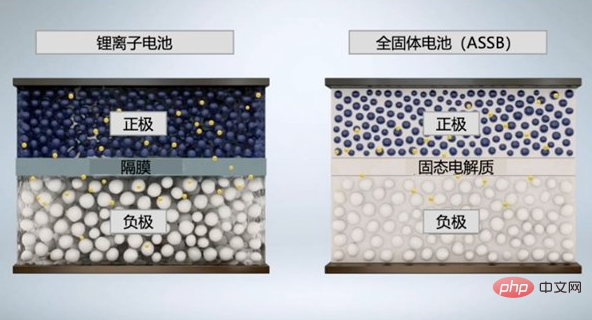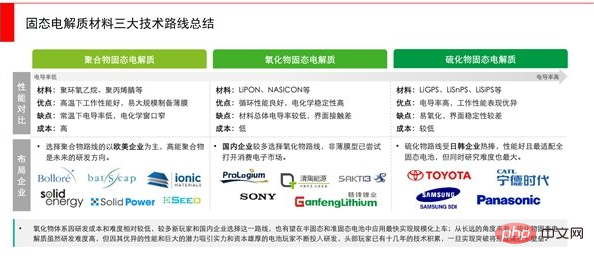
A solid-state battery is a battery that uses solid electrodes and solid electrolytes; a solid-state battery means that there is no liquid at all inside the battery, and inorganic or organic polymer solids are used as the electrolyte of the battery. Solid-state lithium battery technology uses a glass compound made of lithium and sodium as a conductive material to replace the electrolyte of previous lithium batteries, greatly increasing the energy density of lithium batteries. Solid-state batteries have the advantages of good safety, high energy density, and strong cycle performance; the disadvantages are large impedance and high cost.

The operating environment of this tutorial: Windows 7 system, Dell G3 computer.
What is a solid-state battery?
Solid-state battery is a kind of battery technology. Unlike the lithium-ion batteries and lithium-ion polymer batteries commonly used today, a solid-state battery is a battery that uses solid electrodes and solid electrolytes.
Because the scientific community believes that lithium-ion batteries have reached their limits, solid-state batteries have been regarded as batteries that can inherit the status of lithium-ion batteries in recent years. Solid-state lithium battery technology uses a glass compound made of lithium and sodium as a conductive material to replace the electrolyte of previous lithium batteries, greatly increasing the energy density of lithium batteries.

The biggest difference between solid-state batteries and the current mainstream traditional lithium-ion batteries lies in the electrolyte. Solid-state batteries use solid electrolytes to replace the electrolytes and separators of traditional lithium-ion batteries. Traditional lithium-ion batteries mainly consist of positive and negative electrode materials, electrolytes and separators. The positive and negative electrode materials determine the capacity of the battery, and the electrolyte and separator serve as the medium for transporting lithium ions. This is the essential difference.

The mainstream electrolytes of solid-state batteries are polymer, oxide, and sulfide solid electrolytes. European and American cars are dominated by the polymer route; Toyota, LG, Panasonic and other Japanese Korean companies have chosen the sulfide route. my country's leading power battery company CATL has also chosen the sulfide route; Chinese companies such as Beijing Weilan, Jiangsu Qingtao, Ningbo Fengli, and Taiwan Huineng have all chosen the oxide route.

Advantages and disadvantages of solid-state batteries:
Advantages:
Solid-state batteries have the advantages of good safety, high energy density, and strong cycle performance. The disadvantage is that the impedance is larger and the cost is higher. Let’s take a look at them one by one.
1. High energy density, which can reach twice the energy density of current ternary lithium batteries. Under the same weight, double the cruising range can be achieved. For example, the semi-solid-state battery launched by Weilan New Energy has an energy density of 360Wh/kg and may achieve a range of 1,000 kilometers on a single charge. All-solid-state batteries can achieve higher energy density, breaking the current limited energy density of lithium batteries.
2. Good safety performance. Without the liquid electrolyte, there will be no electrolyte leakage or internal short circuit. The solid electrolyte can also better inhibit lithium dendrites and has chemical and electrochemical stability for lithium metal. . If high rate performance and a radical electrochemical system are required, lithium dendrites will also grow in the solid electrolyte under certain conditions, and there is a risk of internal short circuit.
3. Strong cycle life. After the lithium-ion battery uses a solid electrolyte, it solves the problem of the SEI film (solid electrolyte interface film) formed by the liquid electrolyte during the charge and discharge process, and suppresses the appearance of lithium dendrites, thereby greatly improving the cycleability and performance of the lithium-ion battery. service life.
Disadvantages:
Everything has two sides. Where there are advantages, there must be disadvantages. Solid-state batteries are not a panacea either. There are also corresponding shortcomings. Here are 2 disadvantages of solid-state batteries.
#1. The cost of manufacturing is high. There needs to be significant innovation in the equipment and processes of traditional lithium batteries, and the investment in technology research and development is large. Reducing rare elements and lowering manufacturing costs has become the direction of the industry's efforts. At present, semi-solid-state batteries prepared using the oxide route are more than 70% compatible with traditional lithium battery equipment and processes, which can help battery companies make a better transition to solid-state batteries.
2. The interface resistance is too large. The interface between the solid electrolyte and the electrode material is in a solid-solid state. Therefore, the effective contact ability between the electrolyte and the electrode is weak, resulting in ions in the solid material. The transport kinetics are low, resulting in interfacial impedance that affects battery performance.
For more related knowledge, please visit the FAQ column!
The above is the detailed content of What is a solid state battery. For more information, please follow other related articles on the PHP Chinese website!




